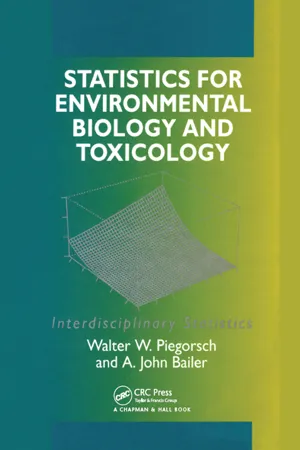
This is a test
- 584 pages
- English
- ePUB (mobile friendly)
- Available on iOS & Android
eBook - ePub
Statistics for Environmental Biology and Toxicology
Book details
Book preview
Table of contents
Citations
About This Book
Statistics for Environmental Biology and Toxicology presents and illustrates statistical methods appropriate for the analysis of environmental data obtained in biological or toxicological experiments. Beginning with basic probability and statistical inferences, this text progresses through non-linear and generalized linear models, trend testing, time-to-event data and analysis of cross-classified tabular and categorical data. For the more complex analyses, extensive examples including SAS and S-PLUS programming code are provided to assist the reader when implementing the methods in practice.
Frequently asked questions
At the moment all of our mobile-responsive ePub books are available to download via the app. Most of our PDFs are also available to download and we're working on making the final remaining ones downloadable now. Learn more here.
Both plans give you full access to the library and all of Perlego’s features. The only differences are the price and subscription period: With the annual plan you’ll save around 30% compared to 12 months on the monthly plan.
We are an online textbook subscription service, where you can get access to an entire online library for less than the price of a single book per month. With over 1 million books across 1000+ topics, we’ve got you covered! Learn more here.
Look out for the read-aloud symbol on your next book to see if you can listen to it. The read-aloud tool reads text aloud for you, highlighting the text as it is being read. You can pause it, speed it up and slow it down. Learn more here.
Yes, you can access Statistics for Environmental Biology and Toxicology by A. John Bailer,Walter. Piegorsch in PDF and/or ePUB format, as well as other popular books in Mathematics & Mathematics General. We have over one million books available in our catalogue for you to explore.
Information
1
Basic probability and statistical distributions
Modern environmental science requires complex, multi-disciplinary collaborations among its practitioners, many of whom hail from diverse fields. At the core of this effort is the data-rich endeavor of observation and experimentation to study the relationships among environmental variables. This is no better exemplified than in environmental biology, where intricate response characterizations exist within biological systems, and where the addition of a toxic environmental agent can have adverse consequences. When data on environmental effects in biological systems are produced from biological sources, it is not uncommon to observe unusual interactions and other unexpected repercussions. The analysis and interpretation of such data often transcend basic statistical methodology, and require more advanced methods. In what follows, we will describe and illustrate analyses appropriate for nonstandard environmental data, centering on biological and toxicological outcomes used to indicate the effects of one or more environmental stimuli. As is true for most statistical approaches, however, the methods will have application in many nonbiological environmental scenarios as well.
We begin with a review of the basic vocabulary and concepts of probability and statistics. Readers familiar with these concepts may wish to skip forward to Section 1.2 on special statistical distributions, or farther on to Chapter 2, where we review basic principles in statistical inference.
1.1 INTRODUCTORY CONCEPTS IN PROBABILITY
1.1.1 Events and their probabilities
At a basic level, an experiment can be viewed as any random process that generates an outcome. We can collect all possible outcomes from a particular random process together into a set, , called the sample space. For any experimental process, an event, , is a particular outcome or collection of outcomes. Probabilities of observing events are defined in a long-term sense, by how frequent the events (or combinations of events) occur relative to all other elements of the sample space. That is, if we conduct an experiment time and time again, counting the number of occurrences of an event of interest, then the ratio of this count to the total number of times the experiment is conducted (a relative frequency) is the probability of the event of interest. We denote the probability of an event as P() for any in the sample space,
Table of contents
- Cover
- Half Title
- Title Page
- Copyright Page
- Dedication
- Table of Contents
- Preface
- 1 Basic probability and statistical distributions
- 2 Fundamentals of statistical inference
- 3 Fundamental issues in experiment design
- 4 Data analysis of treatment-versus-control differences
- 5 Treatment-versus-control multiple comparisons
- 6 Trend testing
- 7 Dose-response modeling and analysis
- 8 Introduction to generalized linear models
- 9 Analysis of cross-classified tabular/categorical data
- 10 Incorporating historical control information
- 11 Survival-data analysis
- References
- Subject Index